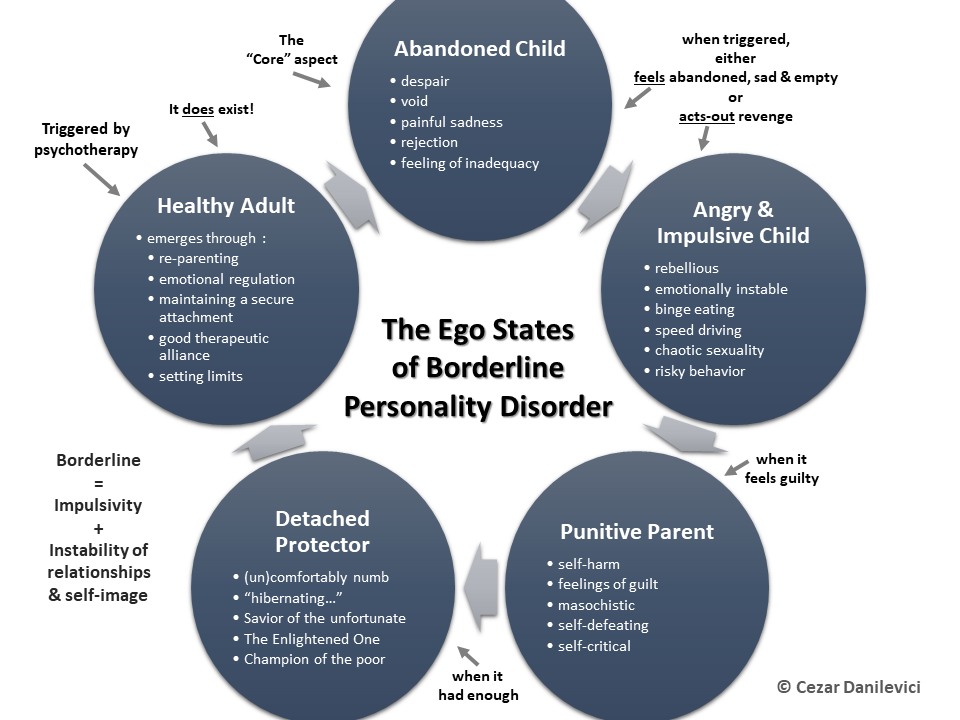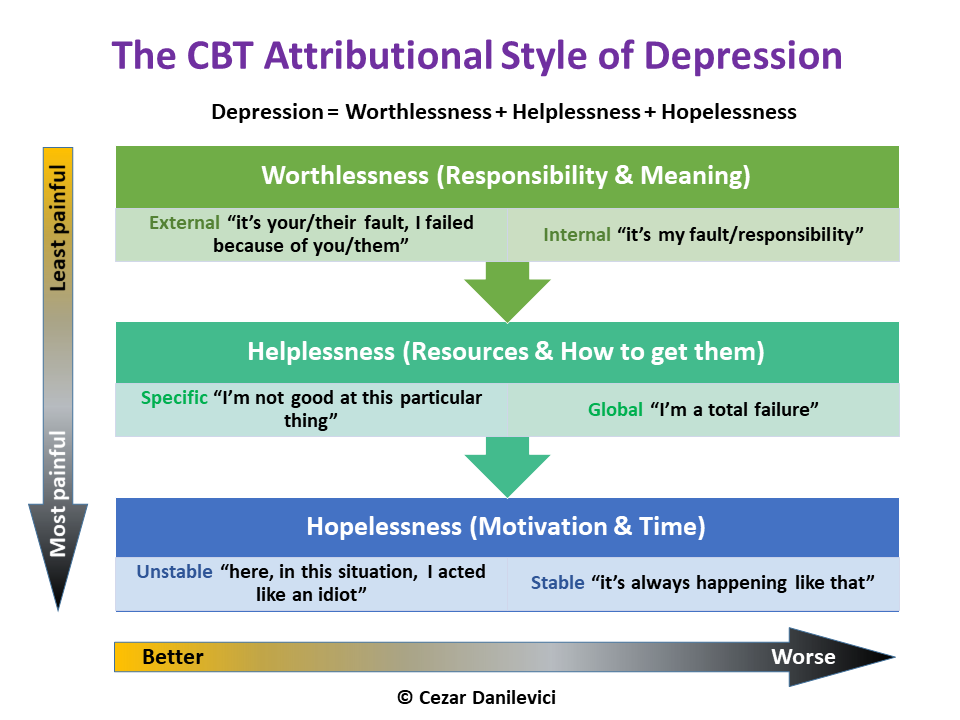There are three musts that hold us back: I must do well. You must treat me well. And the world must be easy.
The cognitivism and behaviorism are the training styles of virtually every psychologist today. The principles of cognitive-behavioral therapy (CBT) are widely known, so I really had a hard time deciding whether it’s worthy to write one more article or not about this subject. So, I intend only to scratch the surface a bit. From the start I must say that the best form of CBT I know is Schema Therapy developed by Jeffrey Young. This technique stands out from the crowd because it’s logical, practical and offers a framework, while also using imagery, almost hypnotic relaxation techniques and coherent protocols for the borderline and narcissist personality disorders. I already have a couple of articles on this subject, such as Lifetraps (link here) or Borderline Ego-States (see below).

So, I shall begin by saying that CBT has limitations when dealing with really deep questions about the human existence. It is famously ineffective on depression or when dealing with wise or intelligent clients who might require some deep insights. The general feeling you get from CBT is that of taming and being tamed; this comes from the Pavlovian work on animals and from the assumption of conditioned reflexes which were replaced by conditioned thoughts and conditioned behavior. On the other hand, CBT is exceptionally effective on anxiety and most types of anger; actually, it’s the method of choice in everything that is phobia, panic, generalized anxiety and so on. It requires a rock hard-patience from the therapist and is very linear, which I personally find remarkably boring.
The main assumption of CBT is that the thought comes first, and the thought gives birth to emotion. In psychodynamics/psychoanalysis, it’s exactly the opposite: an emotion or an inner tendency gives birth to a thought and then to various behaviors. For this reason, the 2 methods are incompatible at the pure philosophical level. Despite this, the methods can be used simultaneously without any problem if this aspect is avoided and the methods are coupled in collaboration and not used head-on.
CBT functions on a well-known formula, the ABC formula:
A x iB(aiT) = C (Em,Cp) > D > E > F > G> H >I
I bet you didn’t expect this… Well, let’s explain:
A is the Activating event, that thing suddenly happening and triggering the symptom; for instance, seeing a spider is an Activating event.
iB (or B) is an irrational Belief, which gives birth to the aiT or the automatic irrational Thought; for instance, if your irrational belief is that spiders are poisonous, aggressive and bite, this will originate an automatic irrational Thought that spider = venomous bite.
A together with iB will give birth to C or a Consequence. This consequence is either an Emotion (Em) or a Comportment (Cp) or behavior, which is either obvious (in the example with the spider, you jump or run away) or subtle (you get a somatic response such as palpitations, shortness of breath or excessive transpiration, sweating palms for instance). If you manage well your fear, you may get only the emotion (Em) and that’s all. At the opposite end, one suffering of spider phobia might get a panic attack.
So, in conclusion, Events mixed with Thoughts generate either Emotions, or Behavior, or Body Sensations. Given the fact that events can’t be controlled, the only option is to change the automatic thoughts, and for this, one needs to access the irrational beliefs beneath the thoughts. The greatest amount of time is spent in CBT discussing, or challenging, these beliefs and their irrational kernel. This discussion is the D in the equation, the Dispute. Following the Dispute, you get an Effect (E), that is, an alternative pathway (thought) which might or might not generate a new Feeling (F). This Feeling needs to be verified thought what is called an ecological verification: the client is put again in the situation and the entire scene is played again using the new thought (E) instead of the old automatic irrational thought (aiT). If all is well, the therapy continues by establishing new Goals (G) for the future which take in consideration the Human nature (H) and lead in the end to a certain Insight (I). If the new thought (E) is not good, the entire process in restarted and the search for an alternative thought resumes. As I said, if it feels linear and robot-like, it’s because it is really so…
How to mix psychodynamics with CBT? Well, when going down to the irrational beliefs that stay at the origin of the irrational thoughts, you enter the unconscious, whether you like it or not, because you’re accessing an inner conflict that is certainly linked to a core belief. How you got that core belief? Is it something you lived? Is it something that was taught by your family? Is it something you decided later in life? Well, this is a debate typical for the psychodynamic techniques…
The CBT has however a different technique and this involves knowing and challenging what is called Irrational Beliefs (link to a previous article here). CBT aims to identify the errors in your judgement and assumes that you can “update” your mental process with these truths. Some people can do this, some can’t. For those who can’t, CBT has some other techniques and other schools of psychotherapy have others, and from here comes a new philosophical debate…
What I use from CBT in my practice? The art of finding the alternative pathway is an outstanding skill and the CBT-trained therapists are excellent debate partners when dealing with irrationality and excellent creative partners when dealing with finding an alternative solution. They are highly resourceful and have crystal-clear rational minds. For a certain population of patients who are very algorithmic in their thought process, CBT works surprisingly well. For heuristic minds, like mine, is however not the method of choice.
As a final element, when doing CBT-style therapy, one needs to pay attention to the distortions of the client’s perceptive field. The perception is subjective because it is influenced by life experience, traumatic past, what is perceived as punishment and reward, core beliefs and the passing of time and the general cycles of life. But, there are also elements one needs to pay attention to:
– One needs Power, Knowledge and Insight because one needs Safety.
– One needs Emotional Attachment and Relationships because one needs to Belong.
These 2 aspects – or needs – must always be taken into consideration, as they shape one’s emotions, thoughts and behavior significantly. They act like hackers of the above schemes.
So, that’s it, some elements of CBT, heavily used by everyone, rarely used by myself… or at least I think so…
—
Related Infographic:



